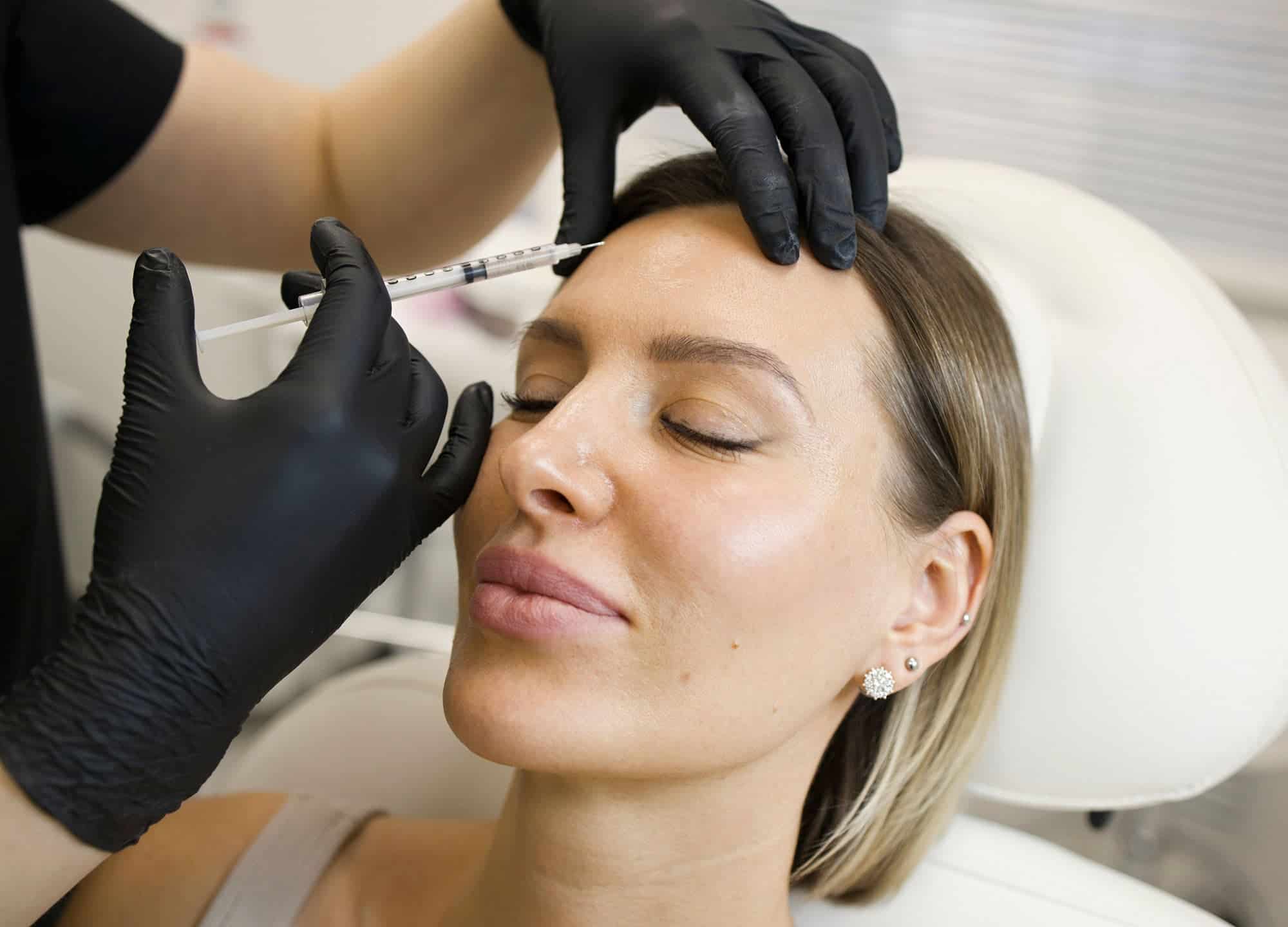For cosmetic virgins and veterans alike, injectables appointments can feel a little daunting. Beyond the numbing and needles, the cost and consent forms, there’s a certain etiquette to be observed—a number of unspoken don’ts to bear in mind. These behaviors, which you may not even realize are taboo, not only drive injectors nuts (or so we hear) but can waste precious time and product, raise risks, and compromise your results.
We were recently tipped off to some of these transgressions when Dr. Janelle Vega, a board-certified dermatologist in Coral Gables, Florida, posted a tongue-in-cheek video for her six-figure following, showcasing various treatment no-nos, along with the quippy caption, “If you want to be on your injector’s good side, you won’t do these things.” Dozens of her fellow injectors chimed in to jokingly commiserate and offer up rules of their own.
Here, top dermatologists reveal exactly what not to do during your next injectables visit.
1. Don’t use your phone during treatment.
Once the needle comes out, phones must go away—on this, injectors unanimously agree. In the Homewood, Alabama, practice of board-certified dermatologist Dr. Corey Hartman, selfies, Zooms, phone calls, and Instagramming are essentially forbidden once treatment begins. “We all need to be 100% focused on the task at hand,” he says. “The only thing I allow patients to hold are stress balls.”
Dr. Daniel Yanes, a board-certified dermatologist in Watertown, Massachusetts, also routinely trades phones for stress balls, finding that many patients are simply looking for a distraction. (And what is an iPhone, really, if not the world’s most expensive fidget?) “From a practical standpoint, having your phone out often means that you’re looking down, which doesn’t give your doctor the best angle from which to inject,” he points out. Plus during treatment, your provider is constantly assessing your face from various perspectives—and counting on you to be present enough to follow their directions and give feedback.
“If your head is bobbing around or you’re distracted and not paying attention to instructions, the treatment becomes more difficult,” notes Dr. Laurel Geraghty, a board-certified dermatologist in Medford, Oregon. “You could wind up with subpar results or, worse still, a complication, like increased bruising or a compromised blood vessel, which raises the risk of pain and scarring.”
This rule applies to all patients—beauty influencers and content creators included—so don’t be surprised if your injector asks you not to record your procedure. “I’ve had patients try to film me, and I always say no,” says Dr. Vega. “I just think, medicolegally, it’s not a great idea.”
2. Don’t touch your face.
Your injector is likely the biggest germaphobe you know—and rightfully so. “There is a large amount of bacteria that lives on everybody’s skin—some are pathogenic, and some are normal [harmless] colonizers,” Dr. Yanes tells us. And if the skin isn’t properly cleansed, those bugs can be injected into your face skin along with your filler and Botox.
“We take great care to sterilize the treatment area with special chemicals, in preparation for injections,” Dr. Hartman says. So when you mindlessly scratch your cheek or finger a nagging wrinkle that you want gone—with less-than-pristine hands—your injector silently freaks before reaching for the antiseptic. “If the sterility of the field is not meticulously maintained, there is a risk of infection,” adds Dr. Hartman. “And this can lead to other complications, like delayed-onset nodules, which don’t appear until months after treatment.”
Infection is a bigger risk with hyaluronic acid fillers than it is with neuromodulators, notes Dr. Yanes, because “the gel matrix of filler has been shown to support the growth of biofilms, which makes them incredibly resistant to antibiotics.” That said, there have been cases of bacterial infections following toxin injections, so avoid touching, regardless of the product used. “If you need to point to something on your face, ask your doctor for a sterile cotton-tipped swab and use that instead of your fingers,” suggests Dr. Yanes.
3. Don’t speak when having your lips done.
Some people get chatty when they’re nervous. Others are simply eager to catch up with their injector after not seeing them for some time. Either way, you’ll want to pause the conversation when having your lips filled.
To create the most precise and natural outcome, providers need to see how your lips look, not only in motion but at rest—and then accurately place the filler in the correct areas and at an appropriate depth. “We have distinct landmarks that we use while injecting lips, to avoid major complications—and a moving target is not ideal [when we’re aiming to] prevent bruising and vascular occlusion,” Dr. Hartman says.
For the record, our experts tell us that they generally appreciate—and even encourage—small talk when treating other parts of the face. “We commonly rely on talkesthesia—chatting to put people at ease and keep the mood light,” says Dr. Geraghty. “But occasionally, patients will get going on a long story during a filler procedure, and I’m sitting there with the syringe in the air, waiting to resume injections, which slows down the procedure.”
4. Don’t dodge the needle.
We get it: evading approaching needles is sort of a basic instinct—but moving mid-jab will most certainly do more harm than good. “The biggest reason not to do this is because it can increase the number of injections that we ultimately have to do, since we lose positioning and can waste product if the target is not where we predict it to be when we inject,” explains Dr. Hartman.
Once your injector has you sufficiently numbed up, try to stay still. “Rest your head back on a pillow for stability, do whatever it takes to relax, and move only as directed by your physician,” says Dr. Geraghty.
5. Don’t stare your injector in the eye.
Getting injectables means temporarily relinquishing personal space. Your injector has no choice but to be in your face for what can feel like an uncomfortable amount of time. So how can you make it less awkward? Avert your eyes. Seriously, don’t stare at them. Apparently this is a thing, and providers find it rather unnerving. Try closing your eyes instead or fixing your gaze elsewhere while they work.
6. Don’t be an armchair injector.
Your injector wants to hear about your beauty goals, past treatment experiences, and any concerns you might have—but they don’t need you schooling them on their craft. Rather than insisting that they use the same filler that your friend got or inject a solid 20 units of toxin across your brow, “trust that your injector knows far more about the nuances, pros, and cons of each individual product and which is best suited for you,” says Dr. Geraghty.
Acknowledging that many folks sign up for aesthetics rewards programs and earn points for brand loyalty, Dr. Yanes feels it’s fine to request a specific brand of filler—Juvéderm, Restylane, Belotero, RHA, Revanesse—but makes the point that under those umbrellas, there’s a variety of fillers, each with distinct properties and intentions. “Thinner fillers are better for areas like the tear troughs and lips, while thicker ones are best to augment the cheeks or chin,” he says. Moreover, some gels are famous for swelling and others are known to blend beautifully in very mobile areas. A good provider weighs all of these factors when choosing the best fillers for you.
When it comes to neuromodulators, again, being partial to a particular brand is A-OK, but don’t presume to know how many units you need. “Each time you get botulinum toxin injections, the dose is unique not only to your face but to your face at that specific point in time,” Dr. Yanes explains. As muscles gradually weaken with repeat treatments, you may need a lower dose. On the flip side, if a muscle gets taxed during a particularly stressful period, relaxing it may require a bit more toxin. The real-time strength and tone of your muscles will largely dictate your dose.
7. Don’t deviate from the plan.
You’ve done a deep dive on your doctor. You’ve googled the treatment options—the risks, benefits, alternatives. You’ve met your injector and devised a master plan. Now all that’s left to do is follow it through—aaand that’s when the doubt creeps in. While it’s perfectly normal to feel nervous, try not to second-guess yourself. “You’re here for a specific treatment—this is not the time to rehash every cosmetic option under the sun or revisit everything we’ve previously discussed,” says Dr. Geraghty. “This only takes away from your treatment and leaves your provider feeling pressed for time,” which isn’t good for anybody.
On a related note, a cosmetic visit isn’t an opportunity to mine for medical advice. Patients often come in for Botox or filler, says Dr. Geraghty, but will then ask their derm about an unrelated concern—a new spot on their neck or an out-of-nowhere rash. Not only do those issues deserve careful, independent evaluation, but they also require medical documentation, especially if a treatment is prescribed—which thereby turns a casual inquiry into a legit medical visit that must be billed as such. “It’s best to carve out separate appointments for cosmetic and medical procedures, to avoid awkward overlap and unexpected insurance bills,” Dr. Geraghty says.
8. Don’t forget to breathe.
“I know it sounds crazy,” says Dr. Hartman, “but patients tend to hold their breath during treatments with filler, which only intensifies the discomfort.” Injections are more tolerable when you focus on your breathing, he explains, “inhaling deeply and then exhaling fully as we inject.”











